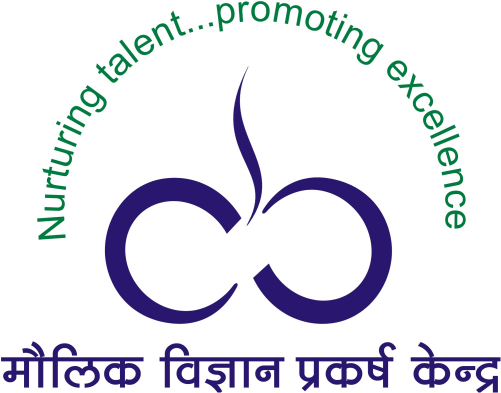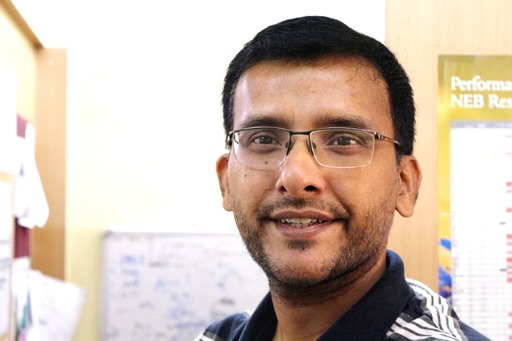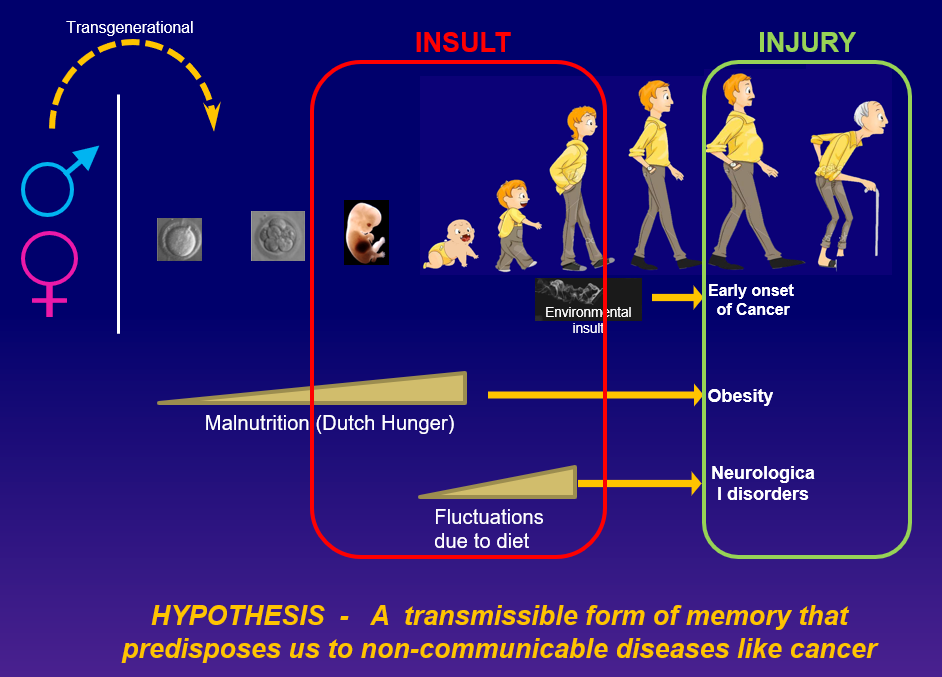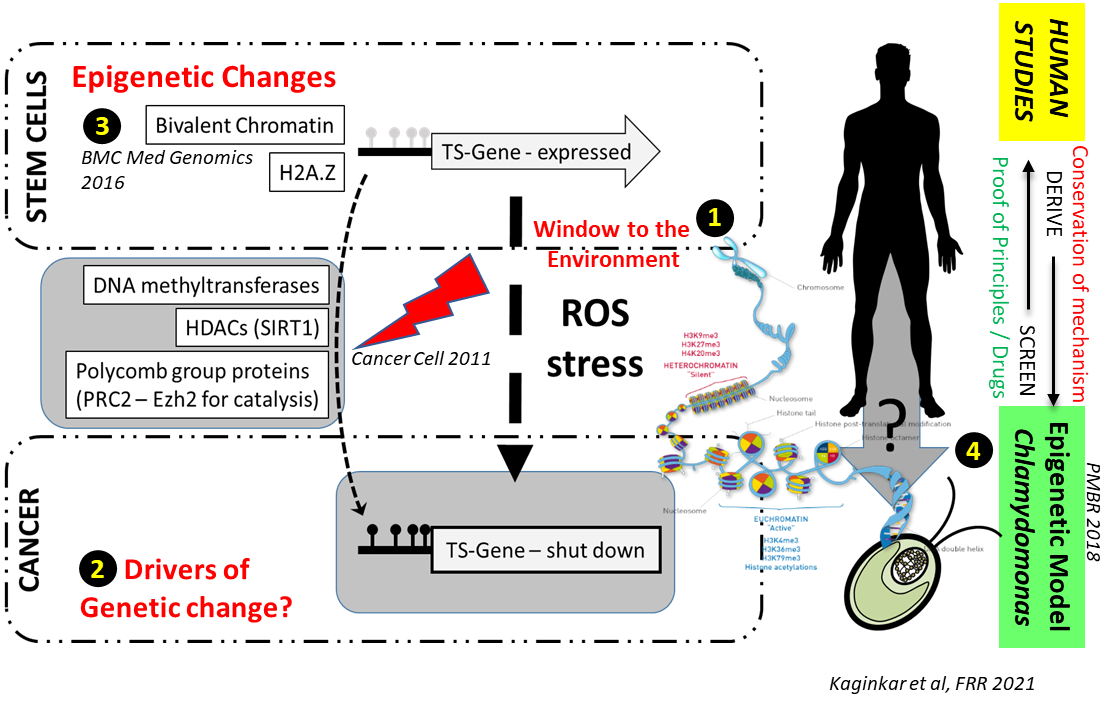



Assistant Professor
Publications
Group Members

Junior Project Assistant

Post-doctoral Fellow

Theme of the Lab:
What pushes a normal cell to become cancerous? Although we appreciate the genetic roots of cancer, we also know that besides mutational burden (genetic loss-of-function), our lifestyle and diet (environmental stress) plays a major role in driving disease susceptibility. A person who starts smoking at an early age (adolescence) suffers from cancer by the time they are ~40 yrs old. Although this is undoubtedly a case of increased susceptibility to disease, the INSULT (exposure to stress) and INJURY (disease outcome) are NEVER COINCIDENT! There must therefore be, some form of ‘memory’ that is remembered and transferred (by stem cells), that eventually affect disease outcomes in somatic tissue at a later age. Our studies point to one such candidate: “epigenetic memories” - encoded as chromatin marks, these are plastic and therefore reversible in nature, harbouring therapeutic potential. Molecular interventions can therefore prevent the disease, before it sets in.
Studies on epigenetic origins of cancer have revealed the molecular underpinnings of a developmental program gone awry. Using environmentally induced oxidative stress (ROS) as a model ❶ we demonstrated how early epigenetic changes directed towards CpG rich containing chromatin can serve as a memory mechanism to shut down tumour suppressor genes (Cancer Cell, 2011). This in turn creates a fertile ground for cancer mutations to proliferate ❷. Yet, the link between the ROS insult and the cancer injury is never coincident; cancer does not occur immediately upon smoking, rather takes at least 15-20 yrs to show up. In further dissecting this dilemma, we queried bivalent chromatin, a stem-cell specific epigenetic mark ❸! By developing a modified sequential-ChIP protocol, we generated the first combinatorial map of histone modifications at mononucleosomal resolution (BMC Med. Genomics, 2016). We concluded that bivalent chromatin consists of doubly marked active as well as repressive histone modifications (namely H3K4me3 and H3K27me3), both on the same mononucleosome, thereby challenging the Allis model of the histone-code hypothesis. Using genome-wide massively parallel sequencing, and correlations to CpG DNA methylation, we hypothesized that H2A.Z and bivalent chromatin together act as the final barriers to cancer specific changes. Could bivalent chromatin thus serve as a contrasting link between “stemness” and a cancer specific epigenome. We propose to query the molecular basis of stress-induced epigenetic memories
that can predispose us towards the cancer cascade. We aim to develop temporally separated cell line
models that help us address these queries.

B. Developing Chlamydomonas reinhardtii as a model system to study stress induced
epigenetic and genetic changes.
Goal: How conserved is ROS induced gene silencing across evolution? In other words, what is the most common denominator of players that hits at the heart of the stress-induced gene silencing ❹. Chlamydomonas, a single celled chlorophyte, popularly known as the "green yeast", mimics the yeast’s haploid-diploid life cycle. Having diversified from animals and plants about a billion years ago, it sits at the evolutionary cusp of multicellularity with its closest volvocine cousins being multicellular. Chlamy therefore presents an excellent evolutionary link to study conserved epigenetic mechanisms across eukaryotes. Having developed phenotypic assays to track epigenetic changes that drive gene expression, we have also generated simple cost-effective molecular tools to assay both candidate genes as well as genome wide profiles of epigenomic changes, due to stress. These assays have helped uncover multiple conservation principles in Chlamydomonas: ROS induced gene silencing, chromatin compaction during gametogenesis, Zn requirements for gametogenesis, etc. We have successfully reverse engineered some conservation principles to develop a transgenic library of Chlamydomonas clones as a high-throughput discovery tool to screen for epigenetically active compounds. Being cost-effective, these libraries can be cultivated and used in any undergraduate microbiology college set-up. We are therefore establishing a network-based drug discovery mode that invites interested collaborators who can use our libraries to screen traditional medicinal plants/sources for epi-drugs. CEBS will act as a nodal centre for channelising such discoveries to molecular characterisation and eventually to test them on human models.
Future: We hope to exploit the mitotic as well as meiotic cycles of this model organism to address molecular basis of transgenerational inheritance in nuclear genomes and how that might affect/influence/interact with organellar genomes. Lastly, being at the cusp of being unicellular versus multicellularity (its close cousin Volvox), we aim to understand the stress-induced epigenetic mechanisms that pushes the organism to shuttle between these two phenotypes. The eventual aim is to discover the common principles of multicellularity. This will not only have basic implications in understanding developmental biology, but also how cancer cells break these multicellular rules to metastasize as unicellular entities and re-establish a multicellular tumour at a distant site.
C. Developing new models for curricular research and education
Being involved with multiple education platforms, we have realised the void of bona fide model systems that can be used in simple laboratory set-ups in India, particularly in rural contexts. In that regard, we are developing diverse models that are validated by hard science in the laboratory, but can be a useful tool not only to learn scientific methods in Biology, but also enable the citizen scientist to ask curiosity driven questions at home. Some examples of problems we have been addressing are: 1) Becoming a microbiologist at home - test the efficacy of antibiotics 2) Estimate the nutrition potential of grains you consume at home. 3) Developing the water-flea as a simple model to understand stress induced gene expression
D. Science, Society and Sexualit
Having worked within four walls of a lab for way too long, many STEM scientists are dissociated from the reality of connecting with the larger ecosystem of common knowledge and disseminating the process of science and scientific temper. In today's age of Social Media polarization, it is the responsibility of scientists to step out of their cocoon and engage the public on larger discussions pertaining to science versus dogmatic beliefs. We need to collectively understand and differentiate - what is scientific. One major area of focus under this umbrella will be understanding the behavioural aspects of sex, gender and sexuality. As we progress further, it is essential for us to understand what makes us different, appreciate the need for that diversity and create inclusive scientific platforms that can have a place for everyone on board, irrespective of your origin, caste, gender, sexual orientation etc. The eventual aim is to continue to the broader conversation with society on various aspects of science: breaking the constructs of normal versus the 'abnormal
Students & Collaborations
Dissertation Students:
Scientific Collaborations:
Drug Discovery Network Collaborations:
Social Responsibility Collaborations and/or Consultancies:
External Links
UM-DAE Centre for Excellence in Basic Sciences
Nalanda Building, University of Mumbai, Vidyanagari, Mumbai 400098, India.
NEST/Outreach:+9186570 26481
NEST/Admissions:+9186570 26482
General Enquiries: info@cbs.ac.in
Admissions Queries:admissions@cbs.ac.in
Web: https://cbs.ac.in